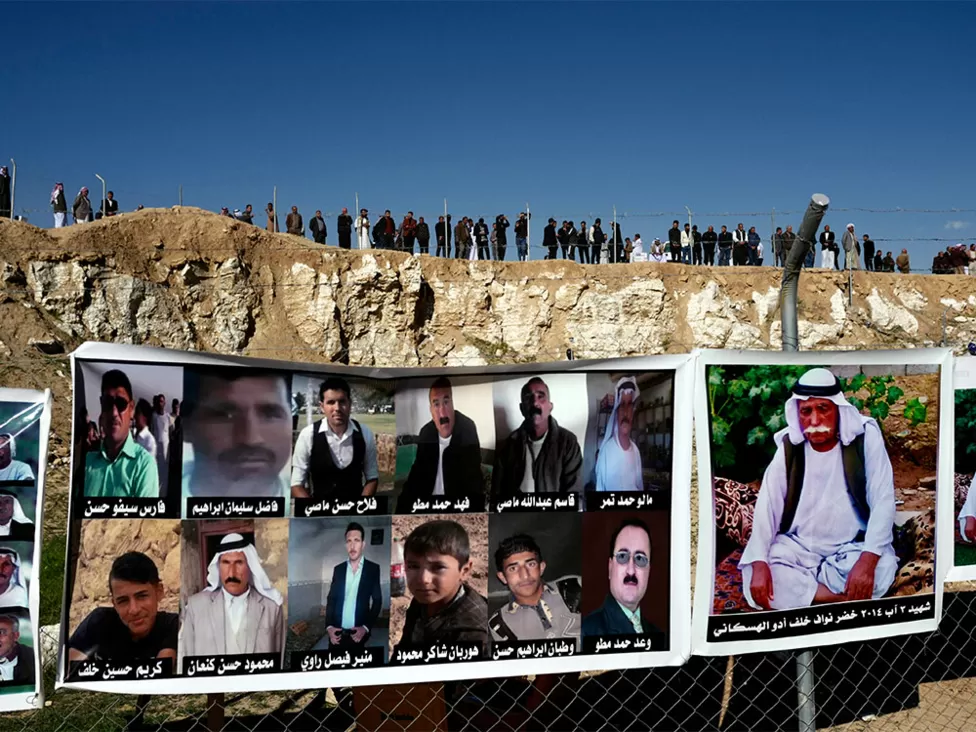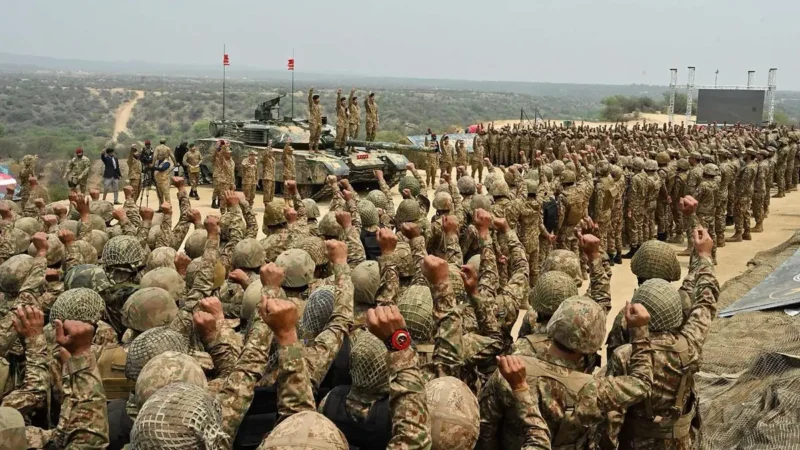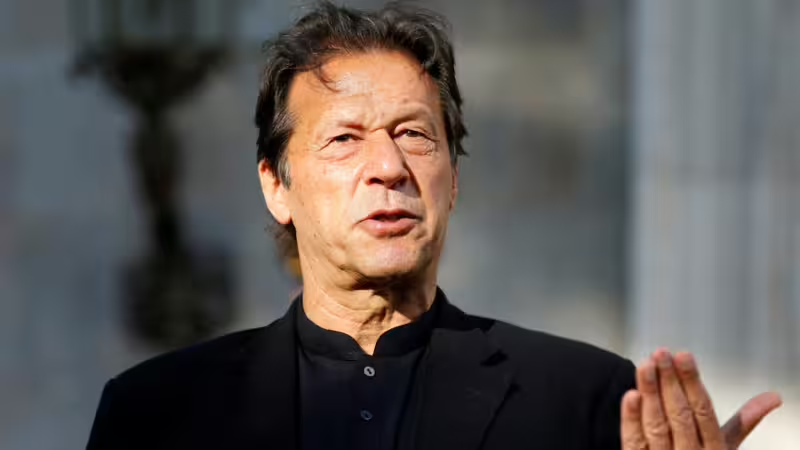The Iraq War 20 Years Later: How the Invasion Sparked Decades of Chaos

Iraq and its people suffered greatly as a result of the attack in March 2003.
More evidence of that, expressed in the shattered lives, could be found at a mass burial site thought to be nearby Sinjar in the Syrian desert.
The Yazidis, survivors of one of Iraq’s destroyed villages, watched as the ground in a marble quarry was dug up. Photos of scores of victims, mostly males, who had been murdered by militants from the Islamic State group were posted on a wire barrier surrounding the area. They came from the hamlet of Zile-li, which is close to the mine where 1,800 men were abducted and murdered on August 3, 2014.
The Yazidis venerate both the Bible and the Quran, and both Christianity and Islam have an impact on their faith. Islamic State attacked them genocidally because they were seen as unbelievers. A clear connection exists between the slaughter and the attack, as well as the catastrophic years that followed, even though it took place after the Americans and British had finished their rule.
Naif Jasso, the Sheikh of Kocho, a Yazidi village that endured an assault even worse than Zile-li, was among those who were observing the dig. He claimed that IS militants, also known as ISIS or Daesh, murdered 517 persons in Kocho out of a total population of 1,250.
Men were taken from their families in Zile-li at gunpoint and killed in the quarry. 16-year-old Sofian Saleh was present in the throng at the dig. Only two guys from Zile-li have survived, and he is one of them. He witnessed another group of men being shot dead as he awaited execution alongside his father, sibling, and 20 to 30 other men. Their remains fell into the quarry from a precipice. It was then their time.
Before the killing, “they took us and threw us on the ground. They tied our hands from behind.”
Despite the death of his father and sibling, Sofian was able to live because corpses landed on top of him and covered him.
Islamic State was employing one of its go-to strategies. The ladies were taken as captives after the males had been slain. In order to indoctrinate them as IS members, moms had to take their children from them. As she recalled the child who had been taken from her and entrusted to a terrorist family, a mother seated close to the presumed burial broke down in tears.
Suad Daoud Chatto, a lady in her 20s, was standing next to the wire fence enclosing the location and holding a placard. It featured the images of the two lost female relations and the nine dead males from her extended family who were murdered. She claimed that in 2014, when she was 16 years old, terrorists abducted her and kept her captive in Syria. She stayed there until the Caliphate was overthrown in 2019, at which point she was saved.
Our wrists were still bound during meals, she said, describing them as “barbarians” who kept them on for a very long period.
They murdered people in front of our eyes. They killed all the Yazidi males, including eight of my brothers. They devastated many families. “They married me off many times… they were wedding the captives. They did not spare anyone.
Only a few sacks of human remains were ultimately discovered there. Numerous others need to be dug up.
The US and the UK had concluded their rule of Iraq by the time the IS ravaged the country in the summer of 2014. Jihadist doctrine predated the incursion and was the motivation behind the 9/11 strikes.
But rather than dismantling Osama Bin Laden’s and the jihadist fanatics’ doctrine, the years of anarchy and cruelty that began in 2003 only served to increase the homicidal jihadist violence. After being temporarily destroyed by a partnership between the Americans and Sunni clans, Al-Qaeda rebuilt into the even more heinous IS.
This year, Iraq has been more secure than it has been in a very long time. Cities like Baghdad, Mosul, and others are much secure. But every day, Iraqis experience the effects of the war. Its effects have significantly altered their nation and affected the lives of millions of people.
The invasion’s disappearance from political and public discourse in the US, which planned and led it, and in the UK, its nearest alliance partner, is a cruel farce. The aftermath of the attack is largely the fault of the Americans and British, and its effects also have an impact on them.
Saddam Hussein, the dictator of Iraq, was well worth ousting because he had tortured, executed, and even used toxic weapons against rebelling Kurds. The wrong method to do it, the US and UK’s disregard for international law, and the bloodshed that erupted in Iraq as a result of the Bush administration’s failure to come up with a plan to replace the power void brought about by regime change were the problems.
The 20 years since the war, in addition to Saddam’s rule, amount to nearly 50 years of torment for the Iraqi people.
brief dark introduction line
It is difficult to reproduce the tumultuous climate of “fear, power, and hubris,” as one scholar recently put it, that engulfed the US in the 18 months between the 9/11 assaults by al-Qaeda and the invasion of Iraq.
A few days after the World Trade Center Twin Towers were demolished, F-15 aircraft were patrolling the skies over Manhattan as I was in New York. As the most powerful military on earth planned its response, it was a clear display of American might.
George W. Bush quickly declared “war on terror” against al-Qaeda and its partner jihadists in response to the shock of the assaults. Tony Blair, the prime minister of the UK, hired a Concorde to fly across the Atlantic to give assistance. He thought that staying near to the White House was the best way for Britain to ensure its global impact.
They made quick progress against the Afghan al-Qaeda network. When the Taliban government resisted handing over Osama Bin Laden, the US-led alliance overthrew it before the year was out. For America, Kabul was not sufficient.
The US was under danger from abroad, according to President Bush and his advisers. They believed that states that disagreed with them might form lethal partnerships with al-Qaeda and its clones. Iraq was the main objective on their radar. Since sending his troops into Kuwait in 1990, Saddam Hussein had been a pain in America’s shoulder. The Americans attempted to create a connection between Saddam and al-Qaeda without any supporting proof. In fact, the secular autocrat who oversaw Iraq saw religious fanatics as a danger.
After the Iraqi invaders were forced out of Kuwait in 1991 by an international alliance put together by the US, the president’s father, George H.W. Bush, made the decision not to overthrow Saddam from his position of authority in Baghdad. If they went on to Baghdad, the first President Bush and his advisers saw problems looming. They were in the midst of a protracted, hostile conquest of Iraq and lacked UN approval to overthrow the government.
When the truce was announced, I was in Baghdad. Officials from the regime I knew had trouble believing that Saddam’s tyranny had endured.
By 2003, twelve years later, America’s anger and power hubris had rendered the second President Bush unaware of the constraints that had bound his father. Mr. Bush and Mr. Blair asserted that previous decisions gave them the power they needed when the US and UK were unable to convince the UN Security Council to adopt a resolution expressly authorizing war and regime change.
Kofi Annan, the secretary-general of the UN, was one of many who did not agree with their position. 18 months after the attack, he claimed that it was “not in conformity” with the UN Charter and thus unlawful in a BBC interview. Other NATO partners, like France, resisted going along with the attack. In the UK, Tony Blair disregarded sizable demonstrations. The remainder of his legislative career was marred by his wartime choice.
There is no more difficult choice for a president or prime minister than starting a conflict. A conflict of choice that George Bush and Tony Blair started resulted in the deaths of hundreds of thousands of people. The invasion’s reasons were quickly revealed to be false. Saddam did not possess the weapons of mass devastation that Tony Blair so persuasively claimed made him an obvious and present threat. It was a managerial failing as well as an information loss.
The American military described the massive airstrikes that launched their assault as “shock and awe.” Neo-conservatives surrounding George W. Bush had the illusion that they could enforce democracy and regional security with the point of a rifle. The Middle East would be stabilized and freedom would spread like a healthy contagion through Syria, Iran, and other countries if the US used overwhelming power.
Within a few weeks, Saddam was gone. Iraqis were not feeling appreciative. The overwhelming majority of them were poor during Saddam’s final ten years in power due to sanctions that were authorized by the UN but were primarily pushed by the US and UK. The British, the Americans, and their friends failed to keep the streets tranquil. The onset of the nightmare years was marked by crime, retaliation, and widespread theft.
Civil conflict between different religious groups resulted from an uprising against the rule. As the Americans enforced a system of government that divided authority along ethnic and political lines – between the country’s three major groups, Shia Muslims, Kurds, and Sunni Muslims – Iraqis turned against one another. Armed groups engaged in combat with the invaders and each other, killing citizens in the process.
Jihadist organizations arrived to take advantage of the turmoil and murder outsiders. Before the Americans were able to assassinate him, Abu Musab al-Zarqawi, a cruel Sunni radical from Jordan, launched assaults to transform the uprising against the rule into a communal civil war. Death teams made their own rule of terror in retaliation as Shias.
Nobody is certain of the precise number of Iraqis who perished as a consequence of the 2003 attack. The range of estimates is in the hundreds of thousands. The Middle East is still experiencing a deadly ethnic wave.
brief dark introduction line
The invasion’s global impact continues to influence current affairs. By toppling Saddam Hussein, who was seen as a Sunni safeguard against the Islamic Republic, the Americans unintentionally shifted the balance of power in Iraq in favor of Iran. Shia leaders who were sympathetic to Tehran were strengthened by his removal. Iran has provided weapons and training to some of the most potent militias in Iraq, and they have representation in the administration.
Fear of starting another catastrophe hindered the US and UK’s reaction to the Arab protests of 2011, particularly President Bashar al-Assad’s war against his own people in Syria.
The commerce in transporting people to Europe is fueled by the unrest in Iraq, where the population is rapidly expanding. Iraqis are the fourth-largest ethnic group using tiny vessels to traverse the English Channel, according to the British Home Office. According to the UK Refugee Council, protection as a refugee is awarded in the overwhelming bulk of instances that have been handled.
While American and British officials no longer ruminate on the war, others have not. The recollection of how the US, UK, and other Western partners who joined the alliance ignored it as they crushed resistance to their invasion of Iraq is one reason why a large portion of the global south remained impartial after Russia attacked Ukraine and disregarded calls to defend international law.
brief dark introduction line
Saddam sentimentality is pervasive in Iraq, not just among his own Sunni group, which is an indication of how terrible the past 20 years have been. People bemoan the fact that, under the previous autocrat, at least you knew where you were. He killed anyone he perceived as an adversary, including his own son-in-law, without discrimination.
A 48-year-old Sunni called Mohammed was furious at the Shia-led administration in Baghdad and the years of communal violence that followed the war as he stood in line for fuel in a settlement close to Mosul.
Saddam was a tyrant and it was one man’s rule, yes, but he wasn’t murdering people based on whether they were Shia, Sunni, Kurdish, or Yazidi, so we hope his rule could return, even for just one day.
Hope is emerging for Iraq. Even though parts of cities and communities are still in rubble and Iraqis continue to confront dangers that would be seen as a national catastrophe in the West, they feel secure. IS extremist groups are being contained by well-trained anti-terrorist forces, but they continue to conduct attacks and ambushes. Shop owners are still anticipating a strong Ramadan, which is typically their busiest season of the year.
Long-term, the American-instituted government structure that distributes power along ethnic and tribal lines may be the greatest impact of the war for Iraq. It has provided enormous opportunities for graft as established by Iraqi leaders.
The estimated sum of theft since 2003 ranges from $150 billion (£124 billion) to $320 billion (£264 billion). The majority of Iraqis, from all groups, who have not reaped the benefits of thievery, experience frequent power outages, contaminated water, and subpar medical treatment in institutions that were once regarded as being on par with those in Europe. Instead of children heading to school, you will typically see them laboring or beggining on most roadways. One of the finest teaching institutions in the Middle East used to be found in Iraq.
Mohammed Shia al-Sudani, the newest prime minister of Iraq, has pledged to make a fresh start. Maintaining his commitment to fight graft, the disease that is devouring the nation from within, will be his greatest struggle. Even while being encircled by stacks of seized currency being returned to Iraq’s government, he conducted a show.
The unwitting casualties, however, are the ones who count most. Not only the deceased, but also millions of Iraqis and people throughout the Middle East whose lives were significantly worsened as a result of the war and its effects.
Activists for the Yazidis pleaded for international security at the collective burial close to Sinjar. The IS militants who committed the murderous murders in 2014, according to survivors, spoke with a dialect from Tel Afar, a neighboring village, and some had an accent from Iraq.
They were still wary of their neighbors, according to Farhad Barakat, a 25-year-old Yazidi fighter who was able to flee to Mount Sinjar and ultimately lived. He claimed that the assassins came from their “neighboring tribes or clans, Arab clans, so how is that possible? The ones who killed us, raped the Yazidi women, they were Iraqis.”





